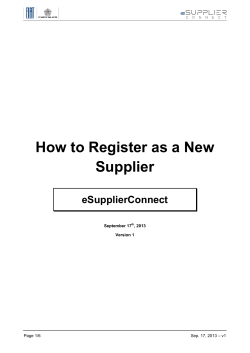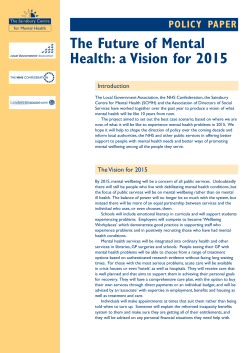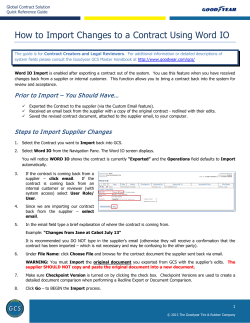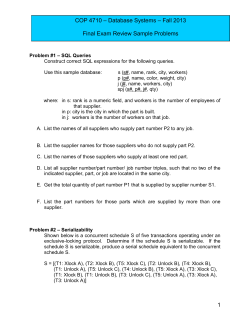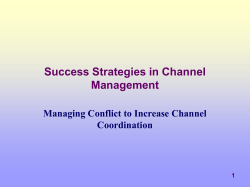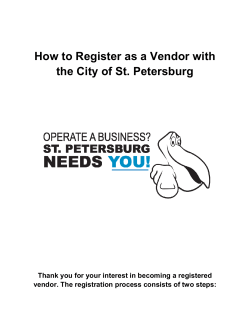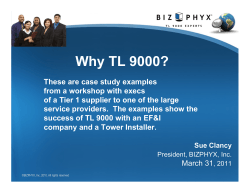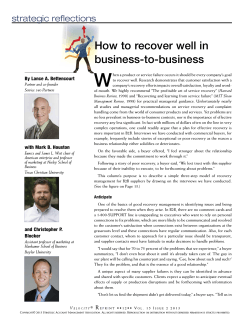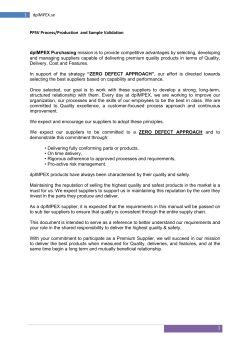
SCMH Overview and Survey “Supply Chain Management Handbook” – Boeing
“Supply Chain Management Handbook” SCMH Overview and Survey Presenter: Darryl Hue – Boeing July 30, 2009 1 Supply Chain Management Handbook (SCMH) Purpose: – Overview of SCMH • Objective and Scope • Project Team and infrastructure • SCMH Chapter and work in progress • How to access (Demo) – Survey • SCMH Assessment model 2 SCMH Objective and Scope Objective: • Provides “How to” guidance material to help improve the “On-Time and OnQuality” performance of products and services throughout the Aviation, Space and Defence industry. Scope: Guidance Material to include: • Deployment support to implement requirements contained in the IAQG (91xx) developed series of Quality Management Systems standards. • Material to support performance improvement of Supply Chain Processes. The SCMH • Is structured in line with a Supply Chain process model covering the entire product lifecycle from development through in-service operations • Is provided for use by companies at all levels in the value chain. . • Will be completed progressively and include regularly updated to incorporate feedback and “lessons learned” from its application. • The contents have been developed by the member companies of the IAQG. 3 Focus on “How” through SCMH 9100 Inputs for future revision of 9100 Requirements Supply Chain Mgmt. Handbook Providing guidance material and best practices on how to meet requirements and achieve objectives New or revised IAQG published documents (Standards, guideline) 91xx 9131 9103 9102 SCMH Guidance material, tools, trainings 4 Active Project Writing Teams Project Management Structure/Resources Project Management Infrastructure LT Core Members: S. Armstrong – UTC (AAQG) C. Buck - Safran (AAQG) L. Weng- Boeing (AAQG) B. Lauras – Airbus (EAQG) S. Komori – FHI (APAQG) SCMH Leadership Team D. Hue (Boeing) – Proj Mgr R. Pardons (IAQG) – Tech mgr M. Iwadare – APAQG Support Contractors - Technical Writers Member Company Volunteers New Product Introduction Special Requirements CI for Small Suppliers Requirements & Flowdown Lean Assess. Tools Risk Management FOD Work Transfer People Capability (PCAP 001) of Notification Change Master Schedule Counterfeit Part Prevention CI for Small Business 9115 Guidance Material Other Topics Other Topics Assessment Checklists SQM Basics Work Instruction Preventive Action Support Resources: Technical Project Mgr Project Manager Future Topics Not assigned FAI Configuration Management • Central project templates • Std. plan and processes • Documented expectations Available Sections • Active Work storage • Standard Processes • Standard templates Key Characteristics Requirements and flow RCAdown & Problem Solving Non-Conformance IAQG Work Space Work Transfer Source Selection In work In Revision Not assigned Completed 5 Plus Member (and non-member) Company Participation IAQG Member Company Participation Non-Members Participation Airbus Gulfstream JPL-NASA ATK Liebherr NQA-USA Avio Lockheed Martin Progress Casting Bell Messier Dowty SEA Boeing MHI Spirit Aero Boeing Canada MTU Triumph Bombardier Parker UL DQS Inc. Dassault Safran Verify Inc Dassault Aviation Spirit AeroSystems EADS Sukhoi Embraer, Brazil Thales ESA UTC Eurocopter Volvo Aero Fuji Heavy industries, LTD Vought GE Aviation Zodiac Goodrich 6 SCMH Chapters and Work in Progress Supply Chain Management Handbook 1. Sales, Master Scheduling & Sequencing 2. Contract Requirements and Flow Down Requirements and flow down templates 3. Design and development 4. Suppliers sourcing selection & approval 5. Plant, material, skills, capacity planning & scheduling Supplier Selection and Capability Assessment Product Performance Detailed Assessment Checklists Special Requirements Critical items New Product Introduction- Quality 9115Software Guidance 6. Order Management and logistic (Internal & external) 7. Manufacturing and inspection 9103 education package (Key characteristics) 9102 Education package (First Article Inspection) Foreign Object Debris (FOD) Lean Assessment Tool 8. Supplier operational management and product validation 9. Control of non conformities, corrective and preventive actions 10. Customer Support (Control of service operations) Root Cause Analysis & Problem Solving Supplier Quality Mgt Basics Control of non conformities 11. Business Management and Customer Satisfaction Monitoring Work Transfer CI for Small Business Risk Management Configuration Management Appendices: Exists In Work New Priority 1 9100 Rev C Deployment Support People Capability (PCAP 001) 7 Available material Chapter SCMH Content Section Chapter 2 – Contract requirement flow down 2.1 Requirements and flow down templates Chapter 4 – Suppliers sourcing selection & approval (Purchasing process) 4.1 Supplier Selection and Capability Assessment Chapter 7 – Manufacturing and inspection (Production and service provision) 7.1 9103 education package (Key characteristics) Chapter 7 – Manufacturing and inspection (Production and service provision) 7.2 9102 Education package (FAI) Chapter 9 – Control of non conformities, corrective and preventive actions (On Time - On Quality) 9.1 Root Cause Analysis & Problem Solving Chapter 9 – Control of non conformities, corrective and preventive actions (On Time - On Quality) 9.2 Control of Non-Conformities Chapter 11 – Business Processes Performance Management and Customer Satisfaction Monitoring 11.1 Work Transfer Appendix A.1 9100 Rev C Deployment Support Appendix A.2 People Capability (PCAP 001) 8 Material In Work Chapter SCMH Content Section Chapter 3 – Design and development 3.1 Special Requirements/Critical items Chapter 3 – Design and development 3.2 New Product Introduction - Quality Chapter 6 - Order Management and logistic (Internal/external) 6.1 Lean Assessment Tool Chapter 8 - Supplier operational management and product validation (Purchasing process) 8.1 Supplier Quality Mgt Basics Chapter 11 – Business Processes Performance Management and Customer Satisfaction Monitoring 11.3 Risk Management Chapter 11 – Business Processes Performance Management and Customer Satisfaction Monitoring 11.4 Configuration Management Chapter 3 – Design and development 3.3 9115 Guidance Material (Software) Chapter 4 – Suppliers sourcing selection & approval (Purchasing process) 4.2 Product Performance Detailed Assessment Checklists (PPDA) Chapter 7 – Manufacturing and inspection (Production and service provision) 7.3 Foreign Object Debris (FOD) 9 Some Frequently Asked Questions • Are all of the requirements of the standard addressed in the handbook? • What is the schedule to complete the handbook or will it be in a continual state of change/improvement? • When will the AS9100 Rev C changes be incorporated into the handbook? • The handbook has training material, procedures and a matrix with guidance. Where did all of this material come from and how is it intended to be used? • What are the restrictions on the use of the material? Is it copyrighted? • There are guidance materials identified as “Best Practices” listed in the handbook. Will the auditors hold companies to this level of performance? Will companies hold their suppliers to these “Best Practices”? • Don’t “Best Practices” vary dependent on the size and complexity of the company? Has it been determined that the “Best Practices” included in the handbook will work in any company? • Some parts of the SCMH have a matrix that gives examples of what the different users can expect from a particular type of company. Are there any instructions on how and when to use the matrix? • Will training on the use of the SCMH be available through IAQG? 10 SCMH Access - Demo http://www.iaqg.sae.org/iaqg/ 11 SCMH Survey SCMH Survey – • Information page – Your Statement of work – Types suppliers you work with • 11 survey areas – aligns with SCMH chapters – Utilize Assessment Maturity Models – Rate your supply base as a whole • Provide a range • Provide a medium – Identify specific “areas of concern” - Possible future topics for the SCMH 12 SCMH Survey – Information Page 13 Supplier Assessment Model (SCMH Section 4.1) Scope: – To assess a supplier’s capability to a set of main domains impacting supply chain performance Purpose of the Model: – Use as a guide to assess the maturity of a supplier to achieve and sustain customer expectations, especially for “On Time” and “On Quality” delivery It is suitable for: – Different product types – Different company sizes – Total or partial application 14 Supplier Assessment Model (SCMH Section 4.1) Five levels of maturity Four domains : • Process • People & Organisation • Tools & Data • Performances Metrics 1: Undefined and not capable 2: Defined and applied, but not 100% efficient or not applied everywhere in the company 3: Defined, applied and effective 4: Predictable 5: Optimised Items for Improvement Action Plan between supplier and customer Expectation Supplier performance 15 Assessment matrices in joined Excel file Title and Definition of the Business Domain Content for each level (from 1 to 5) and each parameter (Process, People and Organisation, etc…) 11 sheets, one per business domain 16 Rating Example Provide your expertise as what “Specific Areas of Concern” need to be addressed as “Possible Topics” to add to the SCMH 17 Exemple of results synthesis (10. Customer support not assessed in this exemple) Expected capability level Assessement results 18 Exemple of results summary: Processes with Strengths and weaknesses 11. Business Processes Performance1. Management and Customer Satisfaction Monitoring • • Strength 1 • 8 – Supplier operational • Strength 2 • management • Strength 3 and product validation • Weakness 1 •9 Weakness 2 non – Control of •confomities, Weakness 3corrective & preventive actions • Strength 1 • Strength 2 • Strength 3 6 – Order management 7 – and Manufacturing logistics and inspection • Weakness 1 • Strength 1 • Weakness 2 • Strength 2 • Weakness 3 • Strength 3 Sales, Master Scheduling 2 – and Contract requirement Sequencing flow down Weakness 1 • Strength 1 Weakness 2 • Strength 2 Weakness 3 • Strength 3 4 – Supply sourcing selection and approval • Weakness 1 3 Design and • – Weakness 2 development • Weakness 3 • Strength 1 • Strength 2 • Strength 3 5 – Planning of product realisation • Weakness 1 • Weakness 2 • Weakness 3 19 Example of results by area 20 Help needed – Your expertise is needed! • Fill out the survey and return to me by end of Workshop • Or mail to: The Boeing Company P. O. Box 3707 mailstop 08-50 Seattle, WA 98124-2207 Attention: Darryl E. Hue • Or scan and email to: “darryl.e.hue@boeing.com” • Remember – Important to identify those critical Supply Chain “Areas of Concern” • Receive input by COB Friday, August 7, 2009 • Names are optional but if you would like to get a copy of the results, please provide email address via separate email 21 Questions? Questions? For any further question or comment, please contact: darryl.e.hue@boeing.com 22 SCMH Back-Up Material Back Up Material 23 Chapter Titles and contents • 1 - Sales, Master scheduling and Sequencing: Balancing and forecasting Medium-Long term customer demand with operational & financial capabilities by optimizing sequence of operations, schedule and resources. • 2 - Contract requirements flow down: Managing Review and flow down of contract requirements from the customers, through all functions internally & to suppliers. • 3 - Design and development: New product introduction activities impacting supply chain performances including product and process essential characteristics management, changes and obsolescence management. • 4 - Supplier sourcing selection & approval: Make or buy process and mapping of the supply chain responsibilities, including partners, suppliers…, Sourcing, Negotiating, & Contracting in line with Make or Buy strategy and Approving suppliers. 24 Chapter Titles and contents (continued) • 5 - Planning of product realisation (Plant, material, skills, capacity planning and scheduling): Plan & optimize the use of resources and means to meet operations planning at plant level. • 6 - Order Management & Logistic (internal & external): Issuing orders, resolving unplanned events & following up till completion including receipt. Collaborative Management of material, services & information to & from the supplier; Optimizing material flow, stock and inventory through the supply chain., up to final customer delivery. Customer property included. • 7 - Manufacturing & inspection (Production & service provision): Manufacturing and product integration processes, including inspection. • 8 - Supplier operational management and product validation (Purchasing process): Operational monitoring and surveillance of suppliers to ensure purchased products and services meet customer requirements (includes initial product validation). Working with suppliers to continually raise their performance levels (Supplier Development activities when required). 25 Chapter Titles and contents (continued) • 9 - Control of non conformities, corrective & preventive actions : Non conformance management and root cause analysis process for all business domains. Raising, notifying, deciding and acting to manage and prevent non conformities (product, processes, documentation, delays, etc...). • 10 - Customer Support: Supporting the customer to ensure end user satisfaction during "in service" phase (Maintenance & Repair, Spares, Training and Documentation, Operating Data feedback and analysis). This includes when applicable, supporting the customer during the product integration activities, up to delivery to the end user (Entry Into Service). TRANSVERSAL PROCESS: • 11- Business Processes Performance Management and Customer Satisfaction Monitoring: Survey, Consolidation and continual improvement of Supply Chain performance (Internal/External), risk and change management, overall decision process to meet customer satisfaction and business objectives throughout Life cycle 26 Supplier Selection and Capability Assessment Model Definition and content of the 5 levels : – 1: Undefined and not capable (No Process, Methods, Tools and/or inappropriate behaviours) – 2: Defined and applied : but not 100% effective or not applied everywhere in the company (capable for low risk products and services) – 3: Defined, applied and effective: repeated satisfactory performance capable – 4: Predictable : performance of proactive improvements towards planned targets, but not systematically on all processes / areas / products – 5: Optimised : best in class, continual improvement fully deployed, involving all stake holders as part of company culture 27
© Copyright 2025



